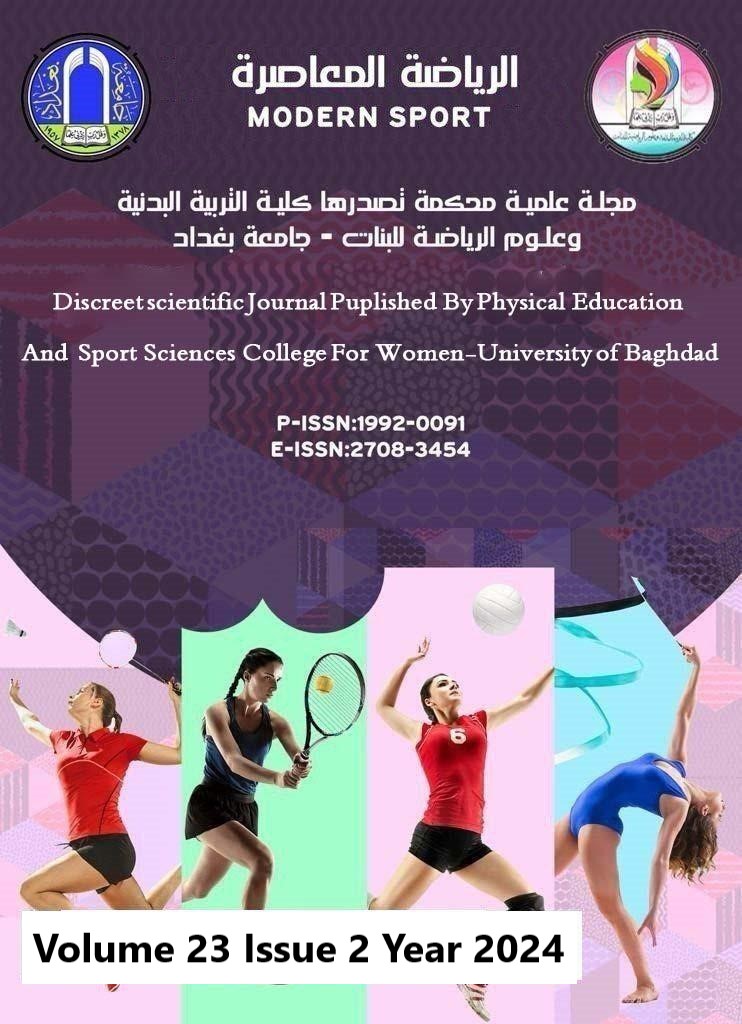استكشاف تأثير تناول الشوكولاتة الداكنة على مقاومة الأنسولين وهرمونات التوتر وتنظيم البوتاسيوم
DOI:
https://doi.org/10.54702/n4418893الكلمات المفتاحية:
مقاومة الأنسولين، HOMA-1R، الكورتيزول، السيروتونين، البوتاسيوم، الشوكولاتة الداكنة 85%الملخص
إن التحقيق في التحسينات الملحوظة في مقاومة الأنسولين وتنظيم هرمونات التوتر، مع التركيز بشكل خاص على مستويات البوتاسيوم، يشكل مجالاً بحثيًا آسرًا. تهدف هذه الدراسة إلى التعمق في التأثير المحتمل لاستهلاك الشوكولاتة الداكنة على هذه الجوانب الفسيولوجية الهامة. من حيث الأهداف، يسعى هذا البحث إلى إجراء فحص شامل وتقييم للتحسينات الكبيرة المحتملة في مقاومة الأنسولين وتنظيم هرمونات التوتر والبوتاسيوم المرتبطة بتناول الشوكولاتة الداكنة. ومن حيث المواد والطريقة، شملت هذه الدراسة 162 فرداً تتراوح أعمارهم بين (40-60) سنة. تم تقسيمهم إلى مجموعتين. تحتوي المجموعة الأولى على 80 شخصًا سليمًا لا يعانون من مقاومة الأنسولين مع مؤشر كتلة الجسم أقل من 29 كجم/م2، وتحتوي المجموعة الثانية على 82 مريضًا يعانون من مقاومة الأنسولين، مع مؤشر كتلة الجسم ≥29 كجم/م2. تم إعطاء خمسة وعشرين منهم قطعة واحدة من الشوكولاتة الداكنة بنسبة 85٪ يوميًا وفقًا لإدارة الغذاء والدواء الأمريكية (شركات جانسن للأدوية. (2019، يناير). لمدة 45 يومًا (جانسن EC، 2023) تم تحليل كلا المجموعتين الجلوكوز في الدم، والأنسولين، والسيروتونين، والكورتيزول قبل وبعد تناول المكملات الغذائية السعرات الحرارية: حوالي 580 سعرة حرارية لكل 100 جرام، مما يزود الجسم بالطاقة: حوالي 43 جرام لكل 100 جرام، معظمها من زبدة الكاكاو، التي تحتوي على مزيج من الدهون الأحادية غير المشبعة والدهون المشبعة: ما يقرب من 46 جرامًا لكل 100 جرام، يعمل كمصدر طاقة أساسي لجسمنا (Santos AC,2023). في النتائج، بعد إجراء الإجراءات الإحصائية لنتائج الموضوعات لكل من HOMA - IR، والكورتيزول، والسيروتونين. وجد أن هناك تغيرًا كبيرًا في القيمة الاحتمالية (0,00)، ومقاومة خمسة وعشرين متبرعًا للأنسولين الخاضعين يوميًا لقطعة واحدة من الشوكولاتة الداكنة بنسبة 85%، مما أدى إلى تحسينات كبيرة: انخفاض الجلوكوز الصائم (84.12 ± 5.6) ملجم / ديسيلتر ، الأنسولين (12.74 ± 4.38) μU / مل، HOMA-IR (2.57 ± 1.02) الكورتيزول (162.8 ± 63.7 ) نانومول / لتر، وزيادة مستويات السيروتونين في المصل (48.8 ± 9.50) نانوغرام / مل، البوتاسيوم (4.6 ± 0.20) ( ملغم/ديسيلتر). في الختام، كشف التحليل الإحصائي، الذي يغطي مستويات HOMA-IR، والكورتيزول، والسيروتونين، عن تغير كبير (قيمة p: 0.00). أدى الاستهلاك اليومي للشوكولاتة الداكنة بنسبة 85% من قبل خمسة وعشرين متبرعًا مقاومًا للأنسولين إلى تحسينات كبيرة، بما في ذلك انخفاض نسبة الجلوكوز في الصيام والأنسولين وHOMA-IR. انخفضت مستويات الكورتيزول بينما ارتفعت مستويات السيروتونين والبوتاسيوم على التوالي. وهذا ما يحقق احد اهداف التنمية المستدامة للامم المتحدة في العراق (الصحة الجيدة).
المراجع
Theilade, S., Christensen, M. B., Vilsbøll, T., & Knop, F. K. (2021). An overview of obesity mechanisms in humans: Endocrine regulation of food intake, eating behaviour and common determinants of body weight. Diabetes, obesity & metabolism, 23 Suppl 1, 17–35. https://doi.org/10.1111/dom.14270
Sovijärvi O, Arina T, Halmetoja J. (2019). Biohacker’s Handbook: Upgrade yourself and unleash your inner potential. Biohacker Center.
Desai K. (2023). Lady Parts: Putting Women’s Health Back Into Women’s Hands. FriesenPress.
Hernández, M. A. G., Canfora, E. E., Jocken, J. W. E., & Blaak, E. E. (2019). The Short-Chain Fatty Acid Acetate in Body Weight Control and Insulin Sensitivity. Nutrients, 11(8), 1943. https://doi.org/10.3390/nu11081943
Janssen J. A. M. J. L. (2021). Hyperinsulinemia and Its Pivotal Role in Aging, Obesity, Type 2 Diabetes, Cardiovascular Disease and Cancer. International journal of molecular sciences, 22(15), 7797. https://doi.org/10.3390/ijms22157797
Paracha, A. I., Haroon, Z. H., Aamir, M., & Bibi, A. (2021). Diagnostic Accuracy of Markers of Insulin Resistance (HOMA-IR) and Insulin Sensitivity (QUICKI) in Gestational Diabetes. Journal of the College of Physicians and Surgeons--Pakistan : JCPSP, 31(9), 1015–1019. https://doi.org/10.29271/jcpsp.2021.09.1015
Brun, N. R., van Hage, P., Hunting, E. R., Haramis, A.-P. G., Vink, S. C., Vijver, M. G., Schaaf, M. J. M., & Tudorache, C. (2019). Polystyrene nanoplastics disrupt glucose metabolism and cortisol levels with a possible link to behavioural changes in larval zebrafish. Communications Biology, 2(1). https://doi.org/10.1038/s42003-019-0629-6
Azevedo I. Stress and obesity. Underst Obes From its causes to impact life, Singapore Bentham Sci. 2020;374–99.
Liu, Y., Zou, X., Zhao, W., Yao, X., Wang, L., Zhou, L., Zhang, R., Luo, Y., Li, M., Zhang, X., Zhu, Y., Cai, X., Zhou, X., Han, X., & Ji, L. (2024). Adrenal limb thickness is associated with metabolism profiles in patients with diabetes: A cross-sectional study. Journal of diabetes, 16(2), e13479. https://doi.org/10.1111/1753-0407.13479
van Galen, K. A., Ter Horst, K. W., & Serlie, M. J. (2021). Serotonin, food intake, and obesity. Obesity reviews : an official journal of the International Association for the Study of Obesity, 22(7), e13210. https://doi.org/10.1111/obr.13210
Zavitsanou, A. ., & Drigas, A. (2021). Nutrition in mental and physical health. Technium Social Sciences Journal, 23(1), 67–77. https://doi.org/10.47577/tssj.v23i1.4126
Xu, H., & Yang, F. (2022). The interplay of dopamine metabolism abnormalities and mitochondrial defects in the pathogenesis of schizophrenia. Translational psychiatry, 12(1), 464. https://doi.org/10.1038/s41398-022-02233-0
McDonough, A. A., & Fenton, R. A. (2022). Potassium homeostasis: sensors, mediators, and targets. Pflugers Archiv : European journal of physiology, 474(8), 853–867. https://doi.org/10.1007/s00424-022-02718-3
Calimag, A. P. P., Chlebek, S., Lerma, E. V., & Chaiban, J. T. (2023). Diabetic ketoacidosis. Disease-a-month : DM, 69(3), 101418. https://doi.org/10.1016/j.disamonth.2022.101418
Kebir, N. E., & Zahzeh, T. (2022). Magnesium Deficiency Associated with Stress, Systemic Inflammation, and Insulin Resistance in Diabetes Mellitus: a review. Egyptian Academic Journal of Biological Sciences. C, Physiology and Molecular Biology, 14(1), 31–46. https://doi.org/10.21608/eajbsc.2022.213962
Jaćimović, S., Popović-Djordjević, J., Sarić, B., Krstić, A., Mickovski-Stefanović, V., & Pantelić, N. Đ. (2022). Antioxidant Activity and Multi-Elemental Analysis of Dark Chocolate. Foods (Basel, Switzerland), 11(10), 1445. https://doi.org/10.3390/foods11101445
Sumiyoshi, E., Matsuzaki, K., Sugimoto, N., Tanabe, Y., Hara, T., Katakura, M., Miyamoto, M., Mishima, S., & Shido, O. (2019). Sub-Chronic Consumption of Dark Chocolate Enhances Cognitive Function and Releases Nerve Growth Factors: A Parallel-Group Randomized Trial. Nutrients, 11(11), 2800. https://doi.org/10.3390/nu11112800
Oliveira, B., Falkenhain, K., & Little, J. P. (2022). Sugar-Free Dark Chocolate Consumption Results in Lower Blood Glucose in Adults With Diabetes. Nutrition and metabolic insights, 15, 11786388221076962. https://doi.org/10.1177/11786388221076962
Fredricks R. (2020). Complementary and Alternative Treatments for Depression. AuthorHouse.
Ortega, M. A., Alvarez-Mon, M. A., García-Montero, C., Fraile-Martinez, O., Guijarro, L. G., Lahera, G., Monserrat, J., Valls, P., Mora, F., Rodríguez-Jiménez, R., Quintero, J., & Álvarez-Mon, M. (2022). Gut Microbiota Metabolites in Major Depressive Disorder-Deep Insights into Their Pathophysiological Role and Potential Translational Applications. Metabolites, 12(1), 50. https://doi.org/10.3390/metabo12010050
Majeed, M. J., Al-Sharifi, Z. A. R., & ibrahim, S. J. (2019). Role of Betatrophin and irisin on Diabetes Mellitus Type1 Management (Experimental Study). Indian Journal of Public Health Research & Development, 10(9), 1135. https://doi.org/10.5958/0976-5506.2019.02595.6
Chen, C., Xia, S., He, J., Lu, G., Xie, Z., & Han, H. (2019). Roles of taurine in cognitive function of physiology, pathologies and toxication. Life sciences, 231, 116584. https://doi.org/10.1016/j.lfs.2019.116584
Bhat, M. A., Ahmad, K., Khan, M. S. A., Bhat, M. A., Almatroudi, A., Rahman, S., & Jan, A. T. (2020). Expedition into Taurine Biology: Structural Insights and Therapeutic Perspective of Taurine in Neurodegenerative Diseases. Biomolecules, 10(6), 863. https://doi.org/10.3390/biom10060863
Botturi, A., Ciappolino, V., Delvecchio, G., Boscutti, A., Viscardi, B., & Brambilla, P. (2020). The Role and the Effect of Magnesium in Mental Disorders: A Systematic Review. Nutrients, 12(6), 1661. https://doi.org/10.3390/nu12061661
التنزيلات
منشور
إصدار
القسم
الرخصة
الحقوق الفكرية (c) 2024 الرياضة المعاصرة

هذا العمل مرخص بموجب Creative Commons Attribution 4.0 International License.















